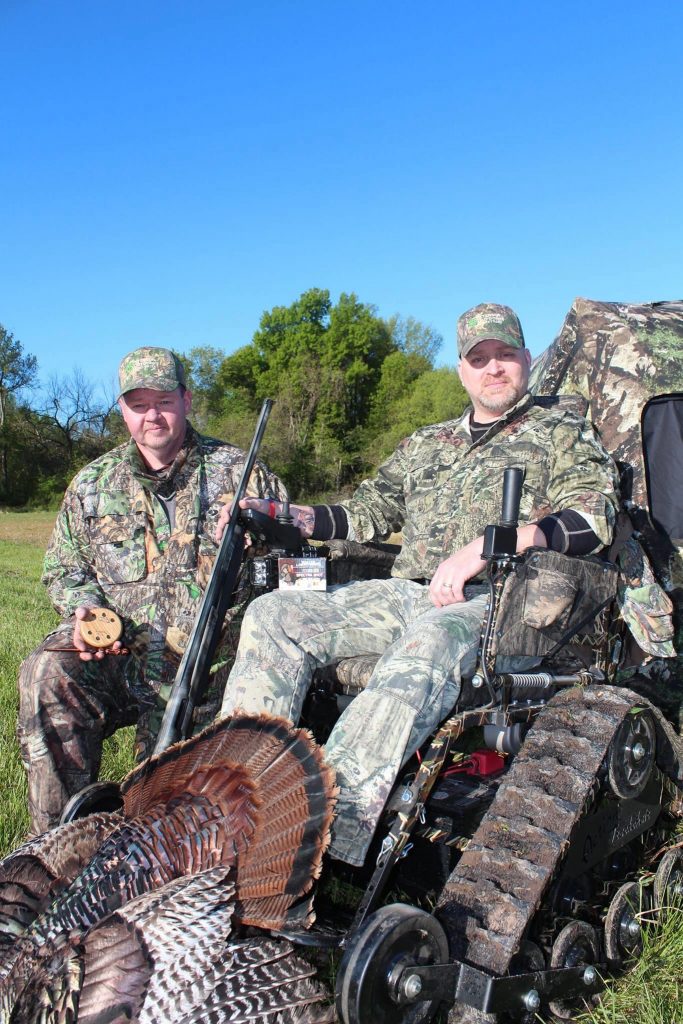Adaptive Equipment for Wheelin’ Turkey Hunters
Peterson Outdoors Ministries (petersonoutdoors.org) has been serving veterans with disabilities through outdoor recreation for over 18 years, and turkey hunting is a big part of the program. POM has perfected using adaptive equipment to get folks into the field and see them succeed.

“The primary challenge with adaptive equipment is matching the prospective hunter’s individual needs to equipment solutions,” says Tron Peterson, founder and executive director of POM. “Both the hunter and the helper/guide must consider every aspect of the hunt to determine what will allow a safe and successful outing. By answering questions about hunter capabilities, a blueprint of needs becomes clear.”
However, the most important question is whether the hunter wants to enjoy a singular outing or incorporate turkey hunting into his/ her lifestyle. If the former, many organizations, like POM, have everything needed to host wheelchair hunters. If the latter, financial challenges may be a deal breaker. Adaptive hunting equipment is pricey.
For most physically challenged hunters, access to the hunting site is a primary concern. Most wheelchairs do not easily traverse rugged terrain, thus other methods of travel are necessary. Further complicating access, is the ability of the sportsman to safely transfer from their chair to adaptive equipment like an Action Trackchair or utility vehicle for transport. Again, asking what’s possible or not brings clarity.
Beyond access come the smaller, but equally important factors. They range from wheelchair-accommodating blinds to sight and hearing enhancement aids, mechanical trigger devices, and sitting and shooting comfort and stability.
“Most hunters are comfortable, stable and safe hunting from their chairs, and prefer them to other options,” Peterson acknowledges. “So, the hunting blind becomes a key focus. The blind must be big enough for a wheelchair, the adaptive equipment attached to the chair, and the hunter’s accompanying caretaker and/or guide. The best designs don’t have entryway thresholds so roll-in entry is possible. Additionally, appropriately positioned shooting windows are a must as is weather protection.”
The next considerations are the items needed for the hunter to take a shot. These needs are focused on hearing enhancement, firearm stability, garnering a site picture through optics, and firing the gun.
Hearing turkeys drum or gobble makes any hunt more exciting and alerts the hunter of a bird in the area. Devices like TETRA Hearing’s ear protection amplify and pin-point turkey sounds while instantly shutting down sudden loud noises, like gunshots, while providing full hearing protection.
Garnering firearm stability can be as simple as using a shooting stick, for those who have use of their upper body and limbs, or gun mounts that attach to a wheelchair. Mounts come in a wide variety of configurations from simple to intricate. Be Adaptive’s High Quad Shooting Mount is a true work of art. It’s designed to be used by people with no arm or hand use and comes with a power trigger to fire the gun. It’s fully adjustable up, down, back, and forth with hand or chin joystick controls. Firing options include sip, bite or two-button push.
Hunters with eyesight limitations, even blindness, are further aided by amazing products like Digital Crosshairs that work with standard optical scopes (not digital scopes). It’s a scope clip-on that connects to an LCD screen showing the site picture with precise crosshairs. Individuals with low vision can overcome the challenge of focusing through a scope’s eyepiece while blind shooters can aim accurately, guided by a spotter’s instructions.
Finally, taking the shot is the real moment of truth. Regardless of disability, there are numerous trigger-pull options. A simple finger control apparatus, like Be Adaptive’s Overhand Finger Control Hand Device, can straighten a curled index finger so the trigger can be pulled, while more complex options like Be Adaptive’s Trigger Mechanism can be configured with sip, bite or two-button push fire.
All told, Wheelin’ Sportsmen have more choices today than ever. With careful assessment of adaptive equipment and hunter needs, days afield targeting turkeys is an option for all.
Adaptive Turkey Hunting Equipment Companies
- 21st Century Scientific, 800-448-3680, wheelchairs.com. Power wheelchairs with off-road capabilities.
- Able Access, 888-504-5611, ablerec.com Shooting mounts and trigger controls.
- Action Trackchair, 507-532-5940, actiontrackchair.com. Motorized trac-+kbased chair, seated and standing positions, 9 models, and accessories.
- ALPS Outdoorz, 800-344-2577, alpsoutdoorz.com. Blinds, packs, vests, furniture.
- AmeriStep Blinds, 877-269-8490, ameristep.com. Ground blinds.
- Be Adaptive Equipment, 877-595-5634, beadaptive.com. Finger and hand controls, gun mounts, digital sights/displays, bite/sip triggers, and accessories.
- Big Sky Imagination, 406-239-8073, bigskyimagination.com. Gun and binocular rests, custom products.
- Bog American Outdoor Brands, 833- 250-6620, boghunt.com. Tripods with/ without gun mount.
- Digital Crosshairs, 404-590-6513, digitalcrosshairs.com. Scopes attachment with screen shows crosshairs for true aim and better visibility.
- Discover Your Mobility Viking, 866-868-9694, discovermymobility.com. Viking 4x4 all-terrain vehicle.
- Heater Body Suit, 888-565-2652, heaterbodysuit.com. Body suit coveralls and accessories.
- Huntmaster Hunting Blind (Growler), 910-948-2114, growlerme.com/fun-stuff Wheelchair accessible blind.
- iScope, 270-465-2311, iscope.com. Scope attachment connects a cell phone to the scope for a better site picture and even for filming.
- IWOM, 814-272-5422, iwomouterwear.com. Adaptive hunting suits.
- John Deer Gator Utility Vehicles, deere.com/en/gator-utility-vehicles-product-list/. Utility vehicles, side-by-side.
- McFadden Machine, 724-459-9278, mcfaden.com. Tripod with gun mount
- NOS 360, 845-337-4914, nos360.com. Rotating, 360-degree, wheelchair platform.
- Ram Mounts, 800-497-7479, rammount.com. Various mounts for phones/tablets, including armrest, seat track, and leg rail mounts.
- Redneck Blinds, 877- 523-9986, redneckblinds.com. Blinds, box, ground and hay bale.
- Roll-A-Ramp, 866-883-4722, rollaramp.com. Roll-up ramps for wheelchairs/scooters.
- Terrain Hopper, 833-846-7737, terrainhopperusa.com. Off-road mobility chair-ATV combo.
- Tetra Hearing, 855-432-7468, tetrahearing.com. Hearing enhancement and ear protection.
- The Standing Company, 800-782-6346, thestandingcompany.com. Stand up wheelchairs.
- Titan Ramps, Discount Ramps, 888-944-6203, www.discountramps.com. Variety of ramps, stationary and portable.
- WheelChairGear, wheelchairgear.com. Wheelchair bags/packs, water bottle accessory, accessory clips.
- Yamaha Motorsports, yamahamotorsports.com. Utility vehicles, side-by-side.
CONNECT WITH US
National Wild Turkey Federation
770 Augusta Road, Edgefield, SC 29824
(800) 843-6983
National Wild Turkey Federation. All rights reserved.